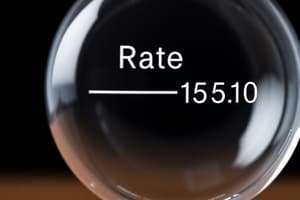Podcast
Questions and Answers
Which of the following statements is true regarding the relationship between thermodynamics and kinetics for a chemical reaction?
Which of the following statements is true regarding the relationship between thermodynamics and kinetics for a chemical reaction?
- Thermodynamics and kinetics both determine the rate of a reaction but are independent of the reaction's equilibrium.
- Thermodynamics and kinetics are not related; one describes the spontaneity of a reaction, and the other describes its rate. (correct)
- Thermodynamics determines how fast a reaction goes, while kinetics determines how far it goes.
- Thermodynamics and kinetics are directly related, with faster reactions always going further towards completion.
The rate law for a reaction can be theoretically determined directly from the balanced chemical equation.
The rate law for a reaction can be theoretically determined directly from the balanced chemical equation.
False (B)
What is the significance of determining the initial rates of a reaction when studying its kinetics?
What is the significance of determining the initial rates of a reaction when studying its kinetics?
Initial rates minimize the impact of decreasing reactant concentrations on the reaction rate.
For the rate law, rate = $k[A]^x[B]^y$, the exponents x and y are known as the ______ with respect to reactants A and B, respectively.
For the rate law, rate = $k[A]^x[B]^y$, the exponents x and y are known as the ______ with respect to reactants A and B, respectively.
Match the following scenarios with the expected change in reaction rate:
Match the following scenarios with the expected change in reaction rate:
In a multi-step reaction, what is generally true about the rate-determining step?
In a multi-step reaction, what is generally true about the rate-determining step?
The units for the rate constant, k, are the same for all reaction orders.
The units for the rate constant, k, are the same for all reaction orders.
Explain how the method of initial rates is used to determine the order of a reaction with respect to a specific reactant.
Explain how the method of initial rates is used to determine the order of a reaction with respect to a specific reactant.
A substance that increases the rate of a reaction without being consumed in the process is called a ______.
A substance that increases the rate of a reaction without being consumed in the process is called a ______.
Match the following rate law expressions with the corresponding reaction order.
Match the following rate law expressions with the corresponding reaction order.
What is the correct unit for a second-order rate constant if the rate is in $mol \cdot L^{-1} \cdot s^{-1}$?
What is the correct unit for a second-order rate constant if the rate is in $mol \cdot L^{-1} \cdot s^{-1}$?
If a reaction is elementary, its rate law can be directly determined from the stoichiometric coefficients of the reactants.
If a reaction is elementary, its rate law can be directly determined from the stoichiometric coefficients of the reactants.
Explain the concept of a pseudo-first-order reaction and provide an example scenario where it might occur.
Explain the concept of a pseudo-first-order reaction and provide an example scenario where it might occur.
The experimental technique used to isolate the effect of a single reactant on the rate of a reaction by maintaining all other reactant concentrations at a constant level is known as the ______ method.
The experimental technique used to isolate the effect of a single reactant on the rate of a reaction by maintaining all other reactant concentrations at a constant level is known as the ______ method.
Match the terms with their definitions in the context of chemical kinetics:
Match the terms with their definitions in the context of chemical kinetics:
For the reaction $2NOBr(g) \rightarrow 2NO(g) + Br_2(g)$, if the rate of disappearance of $NOBr$ is $1.6 \times 10^{-3} mol \cdot L^{-1} \cdot s^{-1}$, what is the rate of appearance of $Br_2$?
For the reaction $2NOBr(g) \rightarrow 2NO(g) + Br_2(g)$, if the rate of disappearance of $NOBr$ is $1.6 \times 10^{-3} mol \cdot L^{-1} \cdot s^{-1}$, what is the rate of appearance of $Br_2$?
Increasing the temperature always increases the rate of a chemical reaction, regardless of whether the reaction is endothermic or exothermic.
Increasing the temperature always increases the rate of a chemical reaction, regardless of whether the reaction is endothermic or exothermic.
Describe how to determine the activation energy ($E_a$) of a reaction experimentally.
Describe how to determine the activation energy ($E_a$) of a reaction experimentally.
In the Arrhenius equation, $k = Ae^{-E_a/RT}$, the term 'A' represents the ______ factor, which accounts for the frequency of collisions and their orientation.
In the Arrhenius equation, $k = Ae^{-E_a/RT}$, the term 'A' represents the ______ factor, which accounts for the frequency of collisions and their orientation.
Match the following orders of reaction with how the half-life changes as the reaction progresses, assuming constant temperature.
Match the following orders of reaction with how the half-life changes as the reaction progresses, assuming constant temperature.
Flashcards
Rate of Reaction
Rate of Reaction
The speed at which reactants are converted into products in a chemical reaction.
Rate Law
Rate Law
An equation that relates the rate of a reaction to the concentrations of reactants.
Rate Constant (k)
Rate Constant (k)
The proportionality constant in the rate law, reflecting reaction speed.
Method of Initial Rates
Method of Initial Rates
Signup and view all the flashcards
Chemical Kinetics: Two Parts
Chemical Kinetics: Two Parts
Signup and view all the flashcards
Rate Measurement
Rate Measurement
Signup and view all the flashcards
Rate (as a gradient)
Rate (as a gradient)
Signup and view all the flashcards
Catalyst
Catalyst
Signup and view all the flashcards
Inhibitor
Inhibitor
Signup and view all the flashcards
Overall Order of Reaction
Overall Order of Reaction
Signup and view all the flashcards
Isolation Method
Isolation Method
Signup and view all the flashcards
Calculating Rate Constant (k)
Calculating Rate Constant (k)
Signup and view all the flashcards
Finding Reaction Orders (x, y)
Finding Reaction Orders (x, y)
Signup and view all the flashcards
Study Notes
- Temperature in Kelvin (K) equals temperature in Celsius (°C) + 273
Chemical Kinetics Part 1
- Chemical kinetics is module 2, lecture 4
- Learning objectives include understanding the rate of reaction, writing rate expressions, understanding rate laws, using initial rates, and using experimental data.
- Textbook for the material is Chapter 14
Thermodynamics and Kinetics
- Thermodynamics describes how far a reaction goes
- Kinetics describes how fast a reaction goes
- Thermodynamics and kinetics are not related.
- Reactions with a negative Gibbs Free Energy (△G < 0) may occur too slowly
- An example reaction is C(s) + O2(g) ⇌ CO2(g) with △G°= -394 kJ mol-1
Study of Reaction Rates
- There is a wide range of reaction speeds
- Studying reaction rates is important
- It helps us understand atmospheric processes, design new drugs, and create industrial processes
Chemical Kinetics
- The study of reaction speed has two parts
- Experimental: Measure reaction rates and study factors influencing rates
- Theoretical: Understand rates in molecular terms and use experimental data to probe reaction mechanisms
Rate Measurement
- Reaction rate is how the concentration changes with time
- For the reaction N2O4(g) ⇌ 2NO2(g):
- Initially, only N2O4 is present
- [N2O4] decreases rapidly at first, then slows to equilibrium
- [NO2] increases rapidly at first, then slows to equilibrium
Understanding Rate
- Speed/velocity is the gradient of a plot of [N2O4] or [NO2] with time
- This gradient is called a rate
- The rate of N2O4 loss is half the rate of NO2 formation due to stoichiometry
Rate Expressions
- Rate = -(change in [N2O4] / change in time) = 1/2 (change in [NO2] / change in time)
- Calculus is used with very small change in time (dt) where: rate = -d[N2O4]/dt = 1/2 d[NO2]/dt
- A negative sign is placed in front of reactants to account for the decrease in concentration
- A rate has to be positive
Generalized Rate Expression
- For a general reaction aA + bB → cC + dD, the rate is:
- Equal to -1/a (d[A]/dt) = -1/b (d[B]/dt) = 1/c (d[C]/dt) = 1/d (d[D]/dt)
- Definition of rate includes the stoichiometric coefficients a, b, c, and d
- [A] and [B] represent reactant concentrations; [C] and [D] represent product concentrations
- The rate can be expressed in terms of any reactant or product
Rate Units
- Units for rate are always concentration/time, typically mol L-1 s-1
Factors affecting reaction rate
- Chemical nature of the reaction
- Physical states of reactants and products
- Concentration of reactants
- Temperature (T)
- Catalysts increase rate (e.g., enzymes)
- Inhibitors decrease rate
- Catalysts and inhibitors undergo no net change
Reaction Rate
- Concentration does not always affect reactions the same way
- Increasing concentration increases rate for some reactions, such as steel wool oxidation
Oxidation of Ethanol
-
For oxidation of ethanol in the liver, increased concentration has no effect on the rate:
-
CH3CH2OH + NAD+ --(alcohol dehydrogenase)--> CH3COH + NADH + H+
-
Reaction kinetics is based on how the rate depends on concentration.
Rate Law Equation
- Rate law describes how rate depends on concentration for the reaction aA + bB → cC + dD
- Rate = k[A]^x[B]^y
- x is the order with respect to A
- y is the order with respect to B
- x + y is the overall reaction order
- k is the rate constant
- Rate law must be determined experimentally
- Stoichiometric coefficients (a, b, c, d) are ignored when finding rate law
Example Rate Laws
- Rate = k [A]^x [B]^y
- 2N2O5(g) → 4NO2(g) + O2(g): rate = k [N2O5] (1st order)
- NO2(g) + CO(g) → CO2(g) + NO(g): rate = k [NO2]^2 (2nd order)
- C2H5Br + OH- → C2H5OH + Br-: rate = k [C2H5Br][OH-] (2nd order)
- (CH3)3CBr + OH- → (CH3)3COH + Br-: rate = k [(CH3)3CBr] (1st order)
- Rate laws are always determined experimentally
- x and y are 0, 1, or 2, but can be negative or fractions.
- x and y are not related to stoichiometric coefficients a, b, c, and d
First-Order Reactions
- Processes that are first order overall (rate = k [A]^x [B]^y):
- Only one reactant A: aA → products (1st order in A)
- Example: 2N2O5(g) → 4NO2(g) + O2(g); rate = k [N2O5]
- Two or more reactants: aA + bB + ... → products
- 1st order in A and zero order in all other reactants
- Example: (CH3)3CBr + OH- → (CH3)3COH + Br-; rate = k [(CH3)3CBr]
- Only one reactant A: aA → products (1st order in A)
Pseudo-First Order Reactions
- The rate law is: rate = k [A][B]
- Concentration of B is much larger than A: [B] >> [A]
- Concentration of [B] does not change much
- [B] is approximately constant
- rate = k’[A]
- k’ (= k[B]) is called the pseudo first-order rate constant
Rate Order
- The affect on doubling concentration
- If the order is equal to 0, there is no Change
- If the order is equal to 1, the rate of reaction doubles
- If the order is equal to 2, the rate of reaction quadruples
Rate Constant
- 'k' is independent of concentration
- 'k' increases with temperature
- Units for 'k' depend on overall order x + y
- If the overall order is:
- 0, the units of k are mol L-1 s-1
- 1, the units of k are s-1
- 2, the units of k are L mol-1 s-1
- 3, the units of k are L2 mol-2 s-1
- If the overall order is:
Rate vs Time
- Rate and time are inversely related
- Dunedin and Christchurch are ~400 km, so if:
- It takes 4 hours to get there, that is one speed
- If it takes 8 hours to get there, that is another speed
- Reaction takes twice as long means the rate is half as fast
Rate Constant Example
- Second order reaction rate = (change in concentration / change in time) = k [A] [B]
- The units are mol L-1 / s
- The unit for rate is always mol L-1 s-1
- k = rate / ([A] [B]) = (mol L-1 s-1) / (mol2 L-2 ) = L mol -1s -1
Measuring Rate
- Units of 'k' change depending on the order of reaction
- Based on initial rates of reaction
- Vary concentration of one reactant, while all others are held constant
- aA + bB → cC + dD rate = k[A]x [B]y
Initial Rates
- Initial rate = k[A]0x [B]0y
- [A]0 and [B]0 are initial concentrations at time = 0
- Orders x and y are unknown
- To find x: measure initial rates for different values of [A]0 while holding [B]0 constant
- To find y: measure initial rates for different values of [B]0 while holding [A]0 constant
Initial Rate Importance
- As reaction proceeds [A] and [B] decrease
- The rate will decrease, thus examine reaction rate over a short time scale
- [A] and [B] remain close to [A]0 and [B]0: Studying initial rates for which the change in [A] and [B] with time is linear
Calculating k
- initial rate = k[A]0x [B]0y
- Obtain values of x and y from experiment
- Calculate k from any set of rate measurements:k= initial rate / ([A]0x [B]0y )
- Remember to work out the correct units for k
Experiment Example
- Experiment used to calculate the experimental rate law for the reaction: S2O8^2- + 3I- → 2SO4^2- + I3-
- Initial rate = k [S2O8^2-]0^x [I-]0^y
- Compare Expts 1 and 2 where [I-]0 is constant in both Expts
- [S2O8^2-]0 is doubled and initial rate doubles
- This makes x = 1
- Compare Expts 1 and 3 where [S2O8^2-]0 is constant in both Expts
- [I-]0 is doubled and initial rate doubles
- This makes y = 1
- Ensure that one reactant is held constant
Calculated Rate Law
- If x and y are determined, the rate law= k[S2O8^2-][I-]
- The overall order the is reaction of S2O8^2- + I- is x + y = 2
- This makes it a 2nd order reaction
- Using data from the experiment, k can be calculated
- This makes the rate constant at 298 K to be 36 L mol -1 s-1
POP Quiz
- The overall homework is to complete Chemistry – the central science 15th Ed by Brown et al. chapter problems 14.7 14.8a 14.12 14.13 14.14
- The answers are provided on the Blackboard
Studying That Suits You
Use AI to generate personalized quizzes and flashcards to suit your learning preferences.




